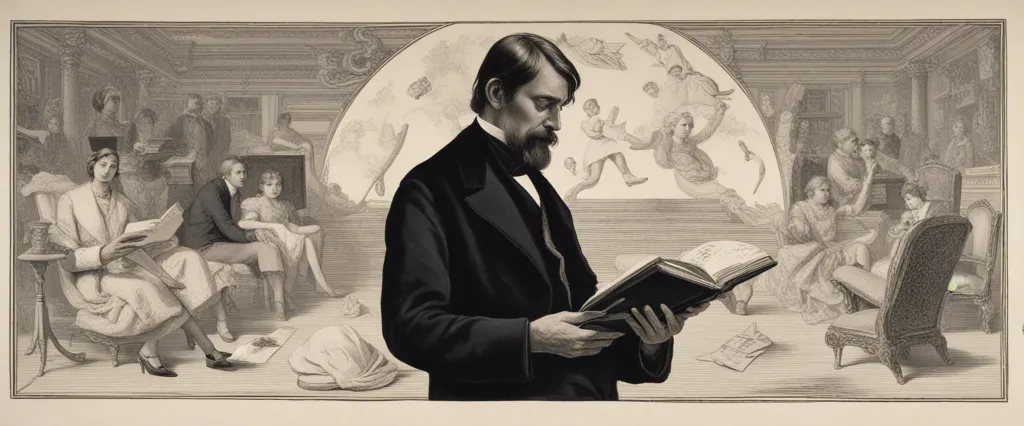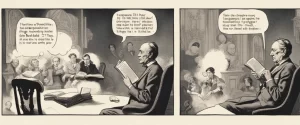——The Theory of the Leisure Class by Thorstein Veblen & Ghettoside by Jill Leovy

In the ever-evolving landscape of sociological research and analysis, numerous literary works emerge to shed light on different aspects of human behavior and society. Two such remarkable books, “The Theory of the Leisure Class” by Thorstein Veblen and “Ghettoside” by Jill Leovy, delve into distinct yet intersecting realms of human existence. Veblen’s seminal work, published in 1899, dissects the intricate dynamics of conspicuous consumption and social status, illuminating the inherent contradictions within societies driven by materialistic ideals. On the other hand, Leovy’s groundbreaking investigation, published over a century later in 2015, meticulously explores the devastating consequences of homicides in African American communities, unraveling the complexities of racism, law enforcement, and social justice in contemporary America. This comparative study aims to delve into the parallels and divergences within both books, emphasizing the timeless essence of societal issues they bring forth and the profound impact they have on our understanding of class, race, and society. By juxtaposing Veblen’s examination of the leisure class against Leovy’s exploration of ghettoside, we seek to discern the common threads that tie them together while recognizing the distinctive contexts in which these works originated.
Brief Summary of Two Books
The Theory of the Leisure Class by Thorstein Veblen
The Theory of the Leisure Class” by Thorstein Veblen, published in 1899, is a sociological work that critiques the emerging industrial society of late 19th-century America. Veblen examines the concept of leisure and its impact on social stratification and human behavior.
Veblen argues that in a capitalist society, the upper class, known as the leisure class, derives its social status from displaying and consuming luxurious goods and engaging in non-productive activities. He coins the term “conspicuous consumption” to describe this behavior, highlighting the wastefulness and futility of this elite’s habits.
According to Veblen, the leisure class’s conspicuous consumption perpetuates a culture of inequality and serves as a form of social control. Members of the leisure class spend lavishly on unnecessary items in order to distinguish themselves from the lower classes, symbolizing their superiority and reinforcing hierarchical divisions in society.
Veblen also explores the idea of “pecuniary emulation,” wherein people throughout the social ladder imitate the behavior and consumption patterns of the leisure class as a means to gain social acceptance or climb the social ladder themselves. This emulation further contributes to the prevailing social inequities.
Additionally, Veblen criticizes the dominant economic system, arguing that industrial capitalism fosters a mindset that values accumulation of wealth and capital over the well-being and needs of individuals. He suggests that this obsession with material gain leads to socially wasteful pursuits and contributes to the class divisions in society.
In “The Theory of the Leisure Class,” Veblen challenges conventional ideas about wealth, social status, and the purpose of work in society. He presents a scathing critique of the leisure class and their extravagant lifestyle, analyzing the negative consequences of their behavior on society as a whole.
Ghettoside by Jill Leovy
“Ghettoside” by Jill Leovy is a non-fiction book that explores the problem of crime, particularly violence against African Americans, in South Los Angeles. Leovy, a journalist, focuses on the story of the murder of a young black man named Bryant Tennelle, and the subsequent investigation led by detective John Skaggs.
The book delves into the history of the Los Angeles Police Department (LAPD) and its relationship with the black community. It sheds light on the rampant violence and lack of effective law enforcement in the area, which often goes unnoticed by the media and society at large. Leovy interviews Skaggs and follows him as he tirelessly pursues justice for victims and their families, highlighting the challenges faced by the detectives working in high-crime neighborhoods.
Leovy argues that the neglect and indifference towards solving crimes in these communities perpetuates a system of injustice, where murderers walk free and families are left without closure. She exposes the difficulties faced by witnesses and victims’ families in coming forward and cooperating with the police out of fear of retaliation.
Throughout the book, Leovy discusses the deep-rooted social issues that contribute to the high crime rates in South Los Angeles, such as poverty, lack of education, and the prevalence of gangs. She also emphasizes the need for improved community policing and the crucial role that detectives like Skaggs play in unraveling the complex web of violence in these neighborhoods.
Ultimately, “Ghettoside” serves as a powerful exploration of the devastating impact of crime on African American communities and calls for a more comprehensive approach to tackling the problem. It is a gripping and thought-provoking investigation into the intersecting issues of race, violence, and justice in America.
Comparison between Two Books

Similarities in Social Change
Both The Theory of the Leisure Class by Thorstein Veblen and Ghettoside by Jill Leovy explore social change from different perspectives, but they share similarities in their analysis of the impact of societal structures and economic disparities.
1. Systemic Inequality: Both books highlight the presence of systemic inequality within society. Veblen focuses on the contrast between the leisure class and the working class, emphasizing the economic disparities and the wasteful consumption patterns perpetuated by the former. Leovy, on the other hand, examines the disparities and injustices faced by marginalized communities within the criminal justice system, specifically focusing on the experiences of African American men living in impoverished neighborhoods.
2. Capitalism and Materialism: Both authors critique the effects of capitalism and materialism on society. Veblen argues that the leisure class perpetuates a culture of conspicuous consumption driven by a desire for social status and prestige. Leovy analyzes how materialistic motives, such as the pursuit of money and status, can contribute to the persistence of violence and disenfranchisement within urban ghettos.
3. Socioeconomic Struggles: Veblen and Leovy also discuss the hardships faced by individuals and communities due to socioeconomic factors. Veblen examines the strain and exploitation of the working class, presenting the leisure class as parasitic in nature, as their wealth is amassed through the labor and sacrifices of others. Leovy delves into the struggles faced by residents of ghettos, including poverty, lack of access to resources, and the cycle of violence perpetuated within these communities due to historical and systemic factors.
4. Need for Social Change: Both books emphasize the need for social change to address and rectify the inequalities and injustices prevalent within society. Veblen argues for a shift towards a more collective and egalitarian society, where the focus is on productive labor rather than ostentatious consumption. Leovy calls for systemic changes within the criminal justice system and society at large to combat the high homicide rates and lack of accountability in inner-city communities.
In summary, The Theory of the Leisure Class and Ghettoside both offer critiques of societal structures and economic disparities, highlighting the need for social change to tackle systemic inequality, the consequences of capitalism and materialism, and the struggles faced by marginalized communities.
Divergences in Social Change
The Theory of the Leisure Class by Thorstein Veblen and Ghettoside by Jill Leovy explore different aspects of society and social change, making their content and perspectives diverge significantly.
Veblen’s The Theory of the Leisure Class, published in 1899, focuses on the concept of conspicuous consumption and its role in shaping social classes. Veblen argues that the leisure class, defined as the wealthy elite, engages in wasteful and non-productive activities to display their social status. By analyzing various societal institutions, such as the education system, Veblen examines how the leisure class maintains its dominance and perpetuates social inequalities. His work primarily highlights the materialistic nature of this class and the ways in which their behaviors and attitudes obstruct social change.
On the other hand, Jill Leovy’s Ghettoside, published in 2015, delves into a completely different aspect of society. Leovy’s book is an exploration of the high murder rates and lack of justice in the African American communities of Los Angeles. She investigates the violence and the deep-rooted systemic issues that contribute to it, emphasizing the role of law enforcement and the criminal justice system. Ghettoside sheds light on the specific challenges faced by people living in these marginalized communities, such as a distrust of law enforcement, racial profiling, and the difficulty of seeking justice for crimes committed against them.
In terms of social change, both books offer differing perspectives. The Theory of the Leisure Class focuses on the need for a shift in attitudes towards consumption and the distribution of resources to reduce social inequality. Veblen argues that a change in societal values, particularly reducing the emphasis on material possessions, is necessary for significant change to occur. However, his work does not offer a specific strategy for implementing these changes.
Alternatively, Ghettoside places a strong emphasis on the need for systemic change within the criminal justice system. Leovy highlights the importance of providing equal access to justice for all members of society, regardless of their socio-economic or racial background. Her book advocates for reform and accountability in law enforcement practices to address the root causes of violence and inequality in marginalized communities.
In conclusion, The Theory of the Leisure Class and Ghettoside analyze different aspects of society but share the common goal of addressing social change. Veblen’s work focuses on reducing materialistic attitudes and wealth disparities, while Leovy’s book emphasizes the need for systemic change within the criminal justice system.

Conclusion
“The Theory of the Leisure Class” by Thorstein Veblen is a classic work of sociological and economic theory. Published in 1899, it critiques the conspicuous consumption and social stratification of the leisure class. Veblen introduces the concept of “conspicuous consumption” and discusses how wealth and social status influence people’s lifestyles.
“Ghettoside” by Jill Leovy, published in 2015, is a non-fiction book that focuses on the issue of homicide in African-American communities and the high rates of unsolved murders. Leovy, a journalist, explores the difficulties faced by detectives in solving these cases and the systemic issues that contribute to the problem. She also provides an in-depth look at the experiences of victims’ families and the impact this violence has on communities.
Both books offer valuable perspectives, but they address different subjects and time periods. “The Theory of the Leisure Class” provides insights into social and economic theories from the late 19th century, while “Ghettoside” examines contemporary issues related to crime and race. Therefore, the choice between the two books ultimately depends on your personal interests and the subject matter you find more compelling.


